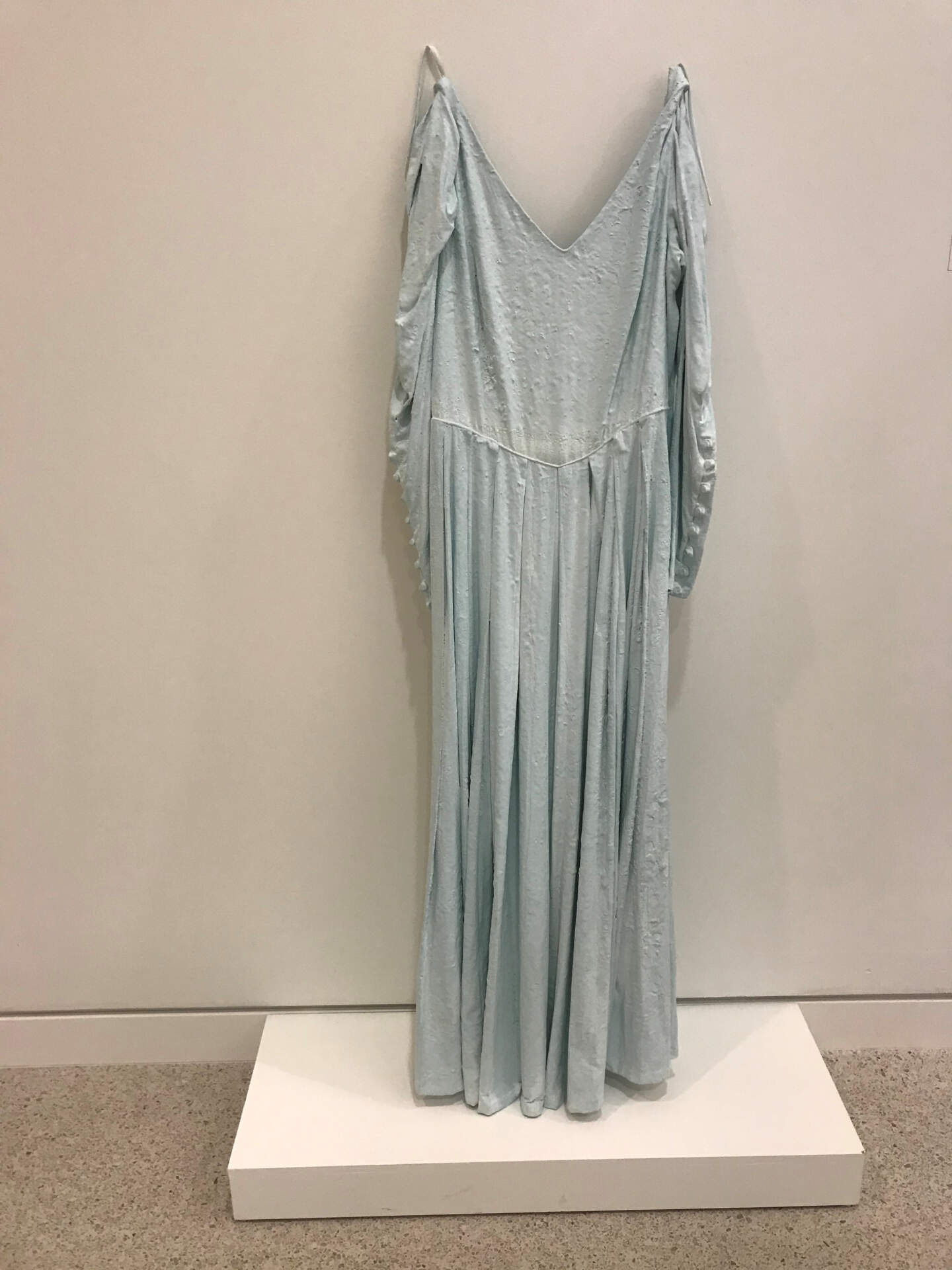Katharine Gaudy (b. 1985)Brittle
2015
wedding gown and plaster
62 x 16 5/8 x 5 inches
Collection of Burchfield Penney Art Center, Purchased with funds from Deb Abgott, Jim and Joy Brandys, and Scott Propeack, 2016
Labels by Madeline Friedler, MST 622, Researching & Presenting Museum Collections, 2020
Feminist philosopher Julia Kristeva defines abjection as “...What disturbs identity, system, order. What does not respect borders, positions, rules.” Buffalo-based artist Kate Gaudy encompasses the disruption of feminine rules by blurring the lines between strong and brittle. Plaster is traditionally a binder that contains its contents. This wedding gown preserved within plaster is now a prison that anyone wearing could not escape from. Gaudy often uses traditionally feminine symbols in her work: Jell-O molds, ceramics, clothing and other craft items. By manipulating the traditional purpose of the object, she made it malfunctional. Wedding gowns are often folded up neatly in a keepsake box to preserve sweet memories, but all one can do now with this statuesque dress in its cocoon of plaster is stand it up or hang it as a hollow presentation of traditional beauty.
For Youths:
Feel the clothes you are wearing. Do they feel soft? The wedding dress here was once soft, but the artist dipped it in a thick substance called plaster. As the plaster dried, it held the dress in the same position forever. If you took it off the wall, it could stand on the floor all by itself! It is both soft and strong, pretty and powerful. Not that long ago, women were expected to get married and stay the same their whole lives. Now, women can choose their own future, to be soft and strong, pretty and powerful. People are just like art. They can be anything they want to be, or just like this dress, they can be many things at the same time.
-----
Brittle was a major component in the series A Billion, Katherine Gaudy’s M.F.A. thesis exhibition which was shown at Big Orbit Gallery in March of 2016. It represents one extreme in the fascination with jettisoned objects, an “ungrounding” of sense. In Julia Kristeva’s words, the jettisoned is abject, defined in part as “... what disturbs identity, system, order. What does not respect borders, positions, rules. The in-between, the ambiguous, the composite.” (Powers of Horror, An Essay on Abjection, 4) (Kristeva is a Bulgarian-French philosopher, feminist, psychoanalyst, literary critic, and novelist who was influenced by the French psychoanalyst Jacques Lacan’s model of psychosexual development.) Gaudy provided this text in connection with her sculpture:
If I say to you “brittle”, what do you think of?
What makes that brittle?
Is it not, that it is both hard and fragile? Is not marriage both these things, of course the connotation has changed. Hard and fragile are transformed from describing the physical to the emotional. To articulate the narrow border of the duality of mind and body.
In my working, I often play dualities against each other in order to navigate into the 'gray' area. We expect that a gust of wind would move the cloth, for it retains the superficial appearance of fabric.
Plaster is a binder, it contains, it is contained, in its borders it touches. Here the plaster makes brittle the dress. It makes the dress malfunction as something to contain a body and in that containment raise a body to a symbol.
“Lift the dress and place it on the floor!”
It will not fold onto itself, it no longer can be thrown into the hamper and take on the shape of the container. It is hardened and can be laid at an angle to the wall. It defies its original laws, its gravity, its definition.
I am not married but this was my first wedding dress, purchased from a second-hand store because it fit my body to a tee and is so classic a representation of the fashion for matrimony. I bought it because it was curious to me for being a specimen that is becoming extinct. That the way I live as a woman would have been unthinkable to my grandmother and even to my mother. Often represented in my work are objects once prescribed as feminine labor (jello molds, clothing, ceramics and craft). My intent with these associations is not one of nostalgia but to hold a microscope to the evolution of these constructed things and also to make them foreign. To make 'things', objects of unknown origin.
The work might also be considered as following in the tradition of ancient Greek and Roman sculpture of the draped female figure, sometimes appearing in ruins without a head or limbs. Another example from antiquity are the six Caryatids that support the porch of the Erechtheion at the Acropolis in Athens. They were mirrored in the female figures sculpted by Augustus Saint-Gaudens for the porticoes of the Albright-Knox Art Gallery that opened in 1905. —Nancy Weekly, 2016
